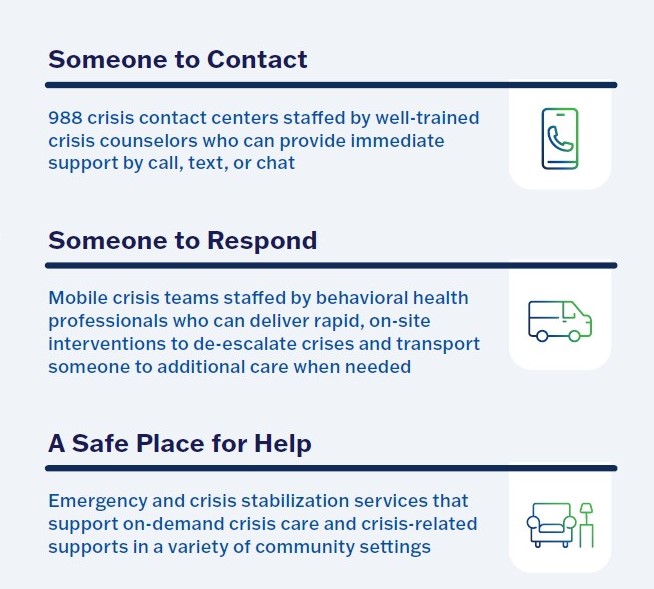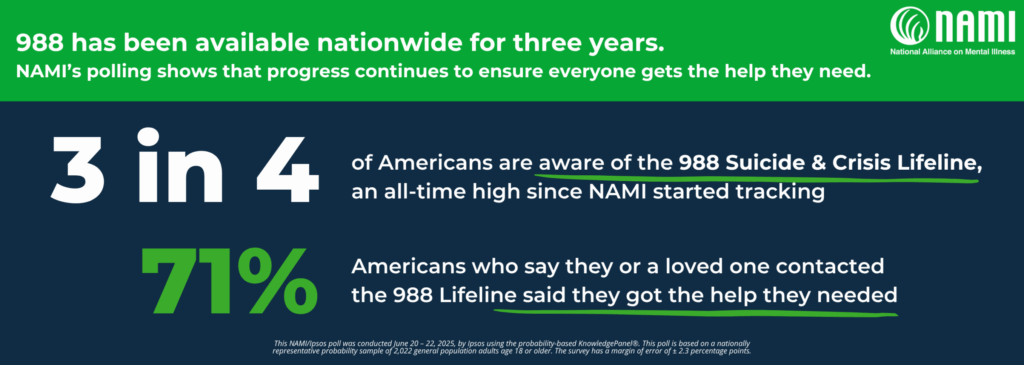If you or someone you know is struggling or in a crisis, help is available.
The 988 Suicide & Crisis Lifeline is available nationwide – 24 hours a day, 7 days a week. This three-digit number is an easy-to-remember way for people to connect with confidential urgent help and support if they or someone they know is experiencing a mental health, substance use, or suicide crisis – or any type of emotional distress.
988 is a lifesaving service with recent research concluding that the vast majority of suicidal callers thought 988 helped them and stopped them from making a suicide attempt.
Anyone can call, text, or chat 988 and be connected to trained crisis counselors within the 988 Lifeline network. 988 is an easy-to-access number that saves lives, but more work is needed to truly #ReimagineCrisis.
NAMI is focused on reimagining crisis response across our country — ensuring that every person in crisis receives a humane response that connects them to appropriate and timely care.
988 is the first step.
The Vision for Crisis Response

It requires federal, state, and local leadership to implement this vision for crisis care in every community and ensure everyone in a mental health crisis gets the help they need, when they need it. The crisis services needed in every community include:
- 24/7 Local Crisis Call Centers (“Someone to contact”)
All contacts to 988 should be answered locally by staff who are well-trained and experienced in responding to a wide range of mental health, substance use and suicidal crises. Crisis call centers should be able to connect people to local services, including dispatching mobile crisis teams and scheduling follow-up appointments with local providers. - Mobile Crisis Teams (“Someone to respond”)
Mobile crisis teams should be available for people in crisis who need more support than can be offered over the phone. Staffed by health and mental health professionals, including peers, these teams can de-escalate crisis situations and connect a person to crisis stabilization programs or other services. Mobile crisis teams should collaborate closely with law enforcement but only include police as co-responders in high-risk situations. - Crisis Stabilization Options (“A safe place for help”)
Some individuals in crisis will need more assistance from crisis stabilization options that provide short-term observation and stabilization. These trauma-informed programs may also identify additional treatment needs and provide a “warm hand-off” to follow-up care, from peer supports and outpatient services to more intensive services, such as hospitalization.
What Is 988?
988 is the nationwide, three-digit number for anyone to contact to be connected to the 988 Suicide & Crisis Lifeline, and it is available via call, text, or chat (988Lifeline.org). When contacting 988, a person is connected to a trained crisis counselor and receives compassionate, accessible care.
- What is 988? 988 is for mental health, suicide, and substance use-related problems — or any type of emotional distress. If you are struggling, contact 988.
- Who can call 988? Any person seeking help can contact 988, but people can contact 988 on behalf of someone else.
- How to contact 988? 988 is available via call, text, and chat (988Lifeline.org). Spanish language services are also available, and translation is available in over 240 languages. 988 now also offers videophone options as well.
- Is 988 free? Yes, 988 is completely free to use.
- What information do I have to share if I contact 988? 988 is confidential. You don’t need to share any information beyond what you are comfortable sharing. 988 welcomes and supports everyone.
- What happens when I contact 988? When someone contacts 988, a trained crisis counselor will answer, listen to you, and provide support and share resources, as needed. 988 crisis counselors are trained to help in a variety of crisis situations, and no one is required to disclose any personal information to receive help.
For most people, calling, texting or chatting 988 is the intervention. Crisis counselors will be able to resolve the urgent needs of the majority of people, reducing the need for an in-person response.
How Is 988 Funded?
Federal Government’s Role: The 988 Lifeline, created by the National Suicide Hotline Designation Act of 2020, is overseen by the Department of Health and Human Services. HHS currently contracts with Vibrant, an external non-profit, to operate the 988 network. Vibrant works with call centers on training, technology, and standards, and operates national back-up centers to ensure that every contact to 988 is answered quickly.
Congress appropriates funding that allows for the national operations for 988 and for grants to states to help fund 988 call centers and services. In Fiscal Year (FY) 2025, Congress appropriated $520 million for this life-saving service.
State and Local Governments’ Role: Much of the work to run call centers and build out crisis response services – and fund these services – happens at the state and local level. Roughly 200 call centers answer 988 contacts across the country.
Federal funds do not cover all costs of 988 center operations, nor is it expected that the federal government will continue to provide states with ongoing grants for 988 indefinitely. To supplement federal funds available to support 988 operations, states can appropriate funds and/or impose small monthly fees on all phone lines (similar to how 911 is funded in the U.S.). NAMI State Organizations and partners across the country are working with state policymakers to implement state legislation that not only includes a fee to fund 988 but also outlines crisis services that will be available statewide to respond to the needs of people contacting 988.
Want to know what your state legislators are doing to support 988 and crisis response? NAMI has an up-to-date, interactive map tracking legislation across the country.
Get Involved
We need mental health advocates across the country to demand a comprehensive crisis system in every community, available to every person who needs it. Here are five ways you can act today:
- Sign NAMI’s petition to show your commitment to reimagining crisis response in your community.
- Share your story to power our advocacy by telling us your own crisis response or 988 experience. The real-life experiences of people who’ve encountered good or bad crisis response help policymakers understand why change is needed.
- Email your members of Congress to tell them to fund crisis response infrastructure.
- Explore how your community can #ReimagineCrisis. Find helpful information and timely resources to use in your advocacy efforts to build a better crisis response system. See if there is any current legislation in your state and connect with your NAMI State Organization to learn how they are supporting legislation and how you may get involved.
- Share information on 988! Post on social media to tell people that 988 is available to everyone, 24/7, across the country – and encourage them to reach out for help if they need it.
NAMI’s 988 & Crisis Response Polls

NAMI and Ipsos have polled Americans since Fall 2021 about 988 awareness and support for 988 funding and services.
Summer 2025 (conducted June 20-22, 2025, of 2,022 U.S. adults)
Spring 2025 (conducted March 21-23, 2025, of 2,049 U.S. adults)
Summer 2024 (conducted June 7-9, 2024 of 2,048 U.S. adults)
Summer 2023 (conducted June 2-11, 2023, and surveyed 2,073 U.S. adults)
Spring 2022 (conducted May 20-22, 2022, and surveyed 2,049 U.S. adults)
Fall 2021 (conducted Oct. 22–25, 2021, and surveyed 2,049 U.S. adults)
Resources to Guide Mental Health Crisis Response
- 2025 National Guidelines for a Behavioral Health Coordinated System of Crisis Care – Published by SAMHSA, these guidelines support mental health authorities, agency administrators, services providers, as well as state and local leaders, and leverage best practices to develop a crisis system of care to meet their communities’ needs.
- 2025 Model Definitions for Behavioral Health Emergency, Crisis, and Crisis-Related Services. A foundational document developed by SAMHSA to support the use of consistent and standardized terms and definitions related to crisis services. In a rapidly growing field, in which communities are developing crisis services to meet their unique needs, this document should be used to support the use of consistent services. This document should be used in conjuncture with the 2025 National Guidelines for Behavioral Health Coordinated Systems of Care.
- NASMHPD 988 Sustainability Fee State Model Bill Template. A template for state legislators, administrators and/or advocates to use to draft state legislation establishing a 988 telecommunications fee to sustainably fund 988. This tool was developed by the National Association of State Mental Health Program Directors (NASMHPD), with input from NAMI and other national mental health advocacy organizations, and has served as the basis for many successful state legislative efforts on 988.
- 988 Crisis Jam Learning Community. Register for a weekly online Learning Community surrounding the efforts around the 988 Lifeline, crisis care, and behavioral health as a whole.
- National Emergency Numbering Association (NENA) Standard for 911/988 Interactions. Developed by the National Emergency Numbering Association, this technical guidance supports 911 entities with a model for developing policies and procedures to working with local 988 call centers.
- A Consensus Approach and Recommendations for the Creation of a Comprehensive Crisis Response System – Developed by fifteen leading organizations in mental health, this evidence-based toolkit offers federal and state policymakers with a guide for implementing a continuum of mental health and substance use care in conjunction with the 988 Suicide and Crisis Lifeline.
Resources
NAMI News
- NAMI Reacts to Elimination of LGBTQ+ Youth Specialized Services in 988
- NAMI Applauds FCC Vote to Require Georouting of 988 Calls
- NAMI, Grassroots Advocates Call on FCC to Improve 988 Routing to Support Local Response
- NAMI Statement on FCC Action to Improve 988 Call Routing
- NAMI Leads 40+ National Organizations to Urge Immediate Improvements to the 988 Suicide and Crisis Lifeline
- NAMI Poll Finds Public Unaware of 988 Before July Launch but Supportive of Policies to Improve Crisis Response
- NAMI Receives Innovation Award for 988 Advocacy Efforts
- NAMI Praises Mental Health Investments in President Biden’s FY 2023 Proposed Budget
- NAMI Statement on the Decision of FCC to Require Text-to-988
- As Launch of 988 Mental Health Crisis Number Looms, NAMI Poll Finds Broad Support for the System and Fees to Fund It
- NAMI Urges Swift Action to Reimagine Crisis Response Ahead of 988 Launch Next Year
- By July 2022, 9-8-8 will be the Nationwide Mental Health Crisis and Suicide Prevention Number
- FCC Designates 988 as a Nationwide Mental Health Crisis and Suicide Prevention Number

